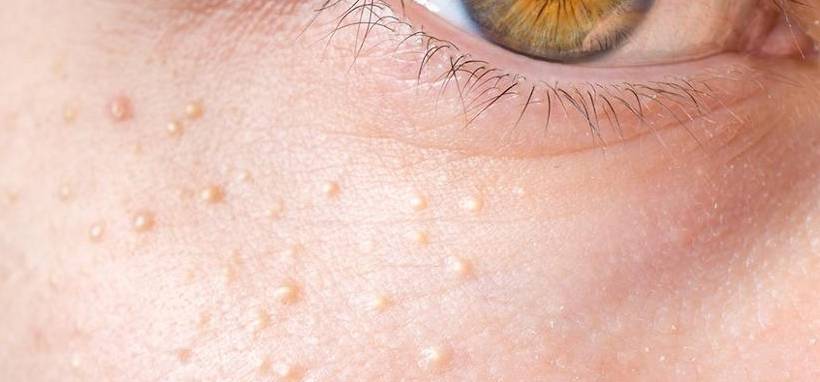Syringoma(汗管瘤): symptoms, prevention and treatment - Dr Yeung Ho Hong 楊浩康

What are the Symptoms of Syringoma
Syringoma, also known as epidermal syringoma, is a benign tumor of the sweat ducts, most commonly occurring in the superficial layers of the skin. These tumors typically present as small, pale yellow or skin-colored nodules with a firm texture, ranging in diameter from approximately 1 to 3 millimeters. The most common location is the eyelids, though they can also appear on other facial areas, the armpits, upper chest, navel, or even the vulva. While most syringomas are asymptomatic and primarily cause cosmetic concerns due to their appearance, in some cases, their number may suddenly increase significantly, leading to a condition known as eruptive syringoma, which can result in psychological stress and social difficulties for patients.
How to Prevent Syringoma
The formation of syringomas is associated with the proliferation of epithelial cells in the sweat glands, particularly the eccrine sweat ducts. Normally, sweat gland cells are distributed in an orderly manner, but when these cells migrate into the dermis during development, they may accumulate abnormally in localized areas, forming small nodules. Although the exact cause remains unclear, genetic factors, endocrine imbalances, and localized skin irritation may all play a contributing role. Some studies have also noted a higher incidence in females, possibly linked to estrogen levels and sebum metabolism.
Clinically, syringomas are characterized by small, round, symmetrically distributed nodules, particularly clustered around the eyelids. These nodules are typically painless and do not cause itching or other discomfort, but their prominent location often affects the patient’s appearance and self-confidence. When located in other areas such as the armpits or upper chest, they may be accompanied by mild inflammation or pigment changes. Occasionally, patients may notice a small black dot on the surface of a syringoma, which is a tiny opening that helps release accumulated keratinous material from within.
Treatment of Syringoma
It is important to note that syringomas can be confused with other skin lesions during clinical differential diagnosis. For example, xanthelasma presents as yellowish-orange lipid deposits; trichoepithelioma may resemble syringomas in appearance; and basal cell carcinoma may also manifest as small nodules in its early stages. As a result, clinicians typically rely on medical history and skin examination to make an accurate diagnosis, and in some cases, a skin biopsy and histopathological analysis may be necessary to confirm the diagnosis.
For most asymptomatic syringomas, active treatment is not required, and regular observation suffices. However, when patients are distressed by their appearance or when syringomas become inflamed, swollen, or painful due to friction or trauma, treatment becomes necessary. Common treatment options include laser therapy and electrocautery. Laser therapy can precisely vaporize the affected tissue to improve appearance, though it may leave minor scars; electrocautery and cryotherapy are also common methods that effectively remove the tumors, but patients must accept the potential for tissue scarring.
In recent years, some studies have explored the use of topical medications to regulate local cell proliferation, though this has not yet become a mainstream treatment. For eruptive syringomas, some patients may require a combination of therapies, including physical destruction of the tumors and adjunctive pharmacological treatment, to reduce recurrence rates. Since syringomas can sometimes recur, regular follow-ups and proper skin care after treatment are essential to detect new lesions early and intervene accordingly.
Prevention of syringomas largely depends on good skin care habits and regular skin check-ups. As syringomas are linked to the proliferation of keratinized skin cells, maintaining skin cleanliness, avoiding prolonged exposure to intense sunlight, and appropriate exfoliation may reduce the risk of their formation. For individuals with a family history or a tendency toward multiple syringomas, enhanced daily care and timely medical consultations are recommended for early detection and management.
Although syringomas are benign, their psychological impact on patients should not be overlooked. Particularly when they appear on the face or other visible areas, they can affect self-esteem and social interactions. Beyond physically removing the lesions, physicians should also address patients’ emotional support and psychological adjustment during treatment. Patients should be informed of the advantages and disadvantages of various treatment options before proceeding and engage in thorough discussions with their doctor to develop a personalized treatment plan.
Furthermore, medical research continues to explore safer and more effective treatment modalities, such as low-energy laser therapy and minimally invasive surgical techniques. These approaches aim to remove lesions while preserving skin integrity and minimizing scarring. For recurrent syringomas, next-generation treatments in clinical trials are showing promising results, offering hope for long-term, stable outcomes for patients.
In summary, syringoma is a common benign sweat duct tumor characterized by pale yellow or skin-colored small nodules, most frequently found on the eyelids and other skin areas. While most syringomas are asymptomatic, they can cause cosmetic concerns and, in some cases, inflammation-related issues. Current treatment options, such as laser therapy and electrocautery, effectively remove the lesions but carry risks of scarring and recurrence. Prevention hinges on diligent skin hygiene and regular check-ups. Patients facing syringomas should select an appropriate treatment strategy based on their individual circumstances and medical advice, aiming to improve their appearance and quality of life.
